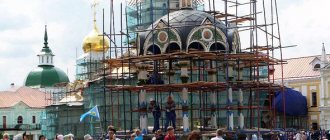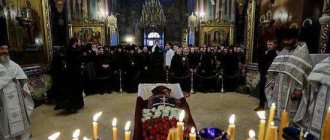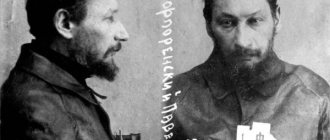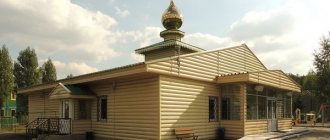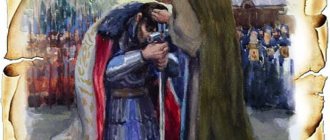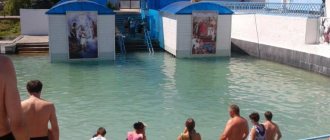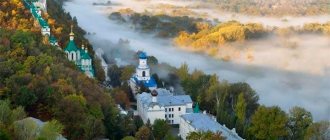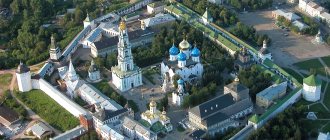| Moscow Donskoy Monastery |
Moscow Monastery in honor of the Don Icon of the Mother of God
, stauropegy of the Russian Orthodox Church within the boundaries of the Moscow Diocese
- Address: Russia, 115419, Moscow, Donskaya square, 1-3
- Tel., 952-14-81
- Official site:
- On the map: Yandex.Map, Google map
Founded by Tsar Theodore Ioannovich in honor of the Don Icon of the Mother of God in gratitude for the deliverance of Moscow from the invasion of the Crimean Khan Kazy-Girey in 1591-1593.
The monastery arose in the place where the camp of Russian soldiers was located, preparing to enter into battle with the Tatar hordes. In the middle of the camp they then placed a camp church of St. Sergius of Radonezh and placed there the revered icon of the Mother of God, nicknamed Donskaya. When in 1591 the Crimean Khan was already on the approaches to the Mother See, Tsar Fyodor Ioannovich ordered a religious procession with the Don Icon around the city walls and then placed it in the marching Sergius Church in the middle of the Russian camp. The pious king then spent a sleepless night in prayer before the icon, and in a vision it was revealed to him that he would win “by the power of Christ and the intercession of His Mother.” The fierce battle lasted almost a whole day, and at the very height of it, the Tatars suddenly turned into a stampede, leaving the dead and wounded and all their belongings or, as they said then, “convoy” on the battlefield, which is why the monastery was called in old Moscow, “that in Oboze."
| Donskoy Monastery. Great Cathedral of the Don Icon of the Mother of God, 2010. Photo: Yu. Bulkin |
In gratitude for the heard prayer and miraculous help, Theodore Ioannovich built a cathedral on the site of the camp in the same 1591 and placed the Don Icon there.
It is possible that the Cathedral of the Don Icon of the Mother of God in 1591-1593. erected by the Moscow architect Fyodor Kon, builder of the White City wall. Almost a hundred years later, next to it, at the expense of Peter I’s sister, Princess Ekaterina Alekseevna, a new cathedral of the Don Icon of the Mother of God was built, much larger in size and therefore nicknamed “Big”, and the first one began to be called “Small”. The Small Cathedral was painted in 1785 by the Italian artist Claudi, who at the same time painted the university church of St. much Tatiana in the old Cossack Main building on Mokhovaya and the Church of St. Martin the Confessor on B. Alekseevskaya (B. Kommunisticheskaya) street near Taganka. There is a version that he carried out his paintings in the Donskoy Monastery according to the sketches of V.I. Bazhenov.
The red monastery walls with beautiful towers, very similar to the walls of the Novodevichy Convent, were erected from 1686 to 1711 at the expense of Yakov Kirillov, the son of the Duma clerk Averky Kirillov, who owned the famous chambers on Bersenevskaya embankment with the house St. Nicholas Church. His son Yakov was also at first a Duma clerk, and then became a monk at the Donskoy Monastery, and the Kirillovs donated a lot to this monastery.
The Donskoy Monastery was robbed and destroyed during the Time of Troubles, during the Patriotic War of 1812 and after the revolution.
The holy Patriarch Tikhon (Bellavin) spent most of his imprisonment in the Donskoy Monastery, enduring slander and persecution from the Bolsheviks and “renovationists.” He lived in two cramped cells almost until his death on April 7, 1925.
The entire Orthodox Moscow buried the Patriarch-Martyr in the Donskoy Monastery. Those who came were not afraid of provocation or the wrath of the Bolshevik authorities.
In 1989, during the renovation of the Small Cathedral, a coffin with the incorruptible relics of Patriarch Tikhon was discovered. In the same year he was canonized as a saint of the Russian Orthodox Church. His St. The relics were placed in a shrine in the Great Cathedral of the Donskoy Monastery.
The necropolis of the Donskoy Monastery is the “Saint-Germain suburb of dead Moscow,” as it was aptly called in the last century. The inhabitants of the old Arbat, Prechistenka, Povarskaya rest on it... The historian V.O. Klyuchevsky, the first elected rector of Moscow University S.N. Trubetskoy, the architect O. Bove, the philosopher P.Ya. Chaadaev, the writers A.P. Sumarokov and M.M. Kheraskov. In the 1930s, the ashes of the artist V.G. Perov were transferred here from the Danilovsky cemetery. The rich landowner Daria Saltykova, who died in captivity in the Ivanovo Monastery, was also buried here.
The Donskoy Monastery is often called an “architectural cemetery.” In Soviet times, he had to hide not only human ashes within his walls, but also bury the lost Moscow. Since 1934, the monastery housed a museum of Russian architecture, and fragments of destroyed ancient monuments were brought to it in order to preserve at least a reminder of the destroyed city. In the eastern wall of the monastery there are high reliefs of the Cathedral of Christ the Savior, in the northern wall there are platbands of the Sukharev Tower and the Church of the Assumption of the Mother of God on Pokrovka.
Soon after the revolution, here, in the monastery church of the Archangel Michael, where the Golitsyns’ tomb was located, they set up a sculpture museum and transferred here the sculpture of the Angel of Joy by the famous master Vitali from the house church of St. much Tatiana Moscow University. Here is also a tombstone from the grave of Prince D.M. Golitsyn, the founder of one of the oldest free hospitals in Moscow for the poor - Golitsyn, now City Clinical Hospital No. 1 named after. Pirogov on B. Kaluzhskaya street. Previously, it was located at the burial site of Golitsyn in the crypt of the hospital church of Tsarevich Dimitri on the territory of the hospital founded by the prince. In 1918, the temple was closed, and according to eyewitnesses, the ashes of the founder (and his soul clerk, cousin, A.M. Golitsyn, the first organizer of the hospital) were reburied in the courtyard, and the tombstone sculpture by F. Gordeev was transported to St. Michael’s Church of the Don monastery, where a museum of memorial sculpture was opened.
In 1936, the dismantled Triumphal Gate, which stood on the square of the Brest (Belorussky) station, was brought to the Donskoy Monastery. Only thirty years later they were reassembled and installed on Kutuzovsky Prospekt in 1967.
Here, in the Donskoy Monastery, in 1927, the first Soviet crematorium was opened - the “cathedra of godlessness,” as atheistic atheistic propaganda called it then. The monastery church of St. Seraphim of Sarovsky, and the construction work was headed by N. Tamonkin, an employee of the architect A.V. Shchuseva.
At the beginning of November 1982, Brezhnev signed an order to transfer the monastery to the Moscow Patriarchate to house the residence of the Patriarch, but the death of the General Secretary, which followed a few days later, suspended the execution of this decision, and in May of the following year the Danilovsky Monastery was given to the Patriarchate.
In 1991, the territory of the monastery was transferred to the Moscow Patriarchate, and monastic life was revived here again. On August 18 of the same year, the Great Cathedral of the monastery was re-consecrated.
On February 19, 1992, the burial of Patriarch Tikhon was opened, and the relics of the saint were found, which were placed in a shrine and subsequently transferred to the Great Cathedral, where they rest openly on the northern part of the sole.
Abbots, governors
- Gury (mentioned 1598)
- Sergius (mentioned 1621)
- Euphrosynus (? - 1634) dismissed
- Theodosius (May 1, 1634 - mentioned 1635)
- …
- Athanasius (November 30, 1678 - February 1681)
- Gerasim (mentioned June 1682)
- Leonty (mentioned June-July 1683)
- Nikon (August 1683 - June 1689)
- Anthony (Odinovich) (mentioned 1692 - mentioned 1697)
- Arseny (Kirillov) (mentioned July 1, 1697 - ?)
- Afanasy (mentioned 1853)
- Paul
- Arkady (Yatsenko) (1862 - 1869)
…
- Nikon (Purlevsky) (1918 - 1919)
- Agathodor (Markevich) (1991 - December 25, 2009)
- Kirill (Pokrovsky) (December 25, 2009 - July 26, 2012)
- Paramon (Dove) (July 26, 2012 - February 26, 2019)
- Foma (Demchuk) (February 26, 2022 - August 25, 2020)
- Evgeny (Kulberg) (August 25 - December 8, 2020)
- Feognost (Guzikov) (from December 8, 2020)
New in blogs
This tragic story began 25 years ago during the late USSR. On one of the April days of 1991, a unique marble plaque “Those who suffered in the feat of martyrdom for the Faith of Christ” was installed on the wall of the Small Cathedral of the Donskoy Monastery. The plaque was installed and consecrated with the blessing of Patriarch Alexy II (Ridiger).
Consecration of a plaque on the wall of the Small Cathedral by the priest of the Donskoy Monastery, Father Kirill.
The unique plaque was dedicated to the feat of Yakov Polozov (cell attendant of Patriarch Tikhon) and all Christians tortured and executed by the Cheka-OGPU-NKVD in the 20th century. The place for its installation was not chosen by chance. It is here, near the wall of the Small Cathedral, that the miraculously preserved grave of Yakov Polozov is located . And opposite his grave, in the premises of the Small Don Cathedral, until 1992 there was a tomb of St. Patriarch Tikhon .
The main initiators of the creation and installation of a memorial plaque on the wall of the Small Cathedral were Alexey Yakovlevich Polozov (son of the new martyr Yakov Polozov), Zaraisk sculptor Nikolai Pavlov , member of the Union of Artists of the USSR and head of the Patriotic Union of Russia Igor Sychev , participant in the storming of the Reichstag Guard Colonel Erofey Levshov - founder in 1970 -year of the “Memory” Movement in defense of cultural and historical heritage (not to be confused with the “Memory” society of the same name by Vasiliev). None of them have been alive for a long time. Some died suddenly, while others were killed under mysterious circumstances. Apparently they were liquidated in order to take revenge on them for installing the slab to the 20th century Martyrs in the Donskoy Monastery. According to one version, their murder was beneficial to several church and secular officials, including from the staff of the Donskoy Monastery, among whom were the descendants of the murderers who participated in the liquidation of Yakov Polozov and Patriarch Tikhon, and the mass executions of Orthodox clergy and laity. The spiritual heirs of these executioners still serve in the structures of the Russian Orthodox Church MP and the Donskoy Monastery. (Details about this at the end of this article.) It was they who recently organized a public atheistic action to demolish and destroy the consecrated plaque on the wall of the Small Cathedral for Orthodox people who suffered for the Faith.
It all started with the fact that electronic media on the Internet reported that high-ranking church and secular officials organized in the Donskoy Monastery the public desecration and destruction of the only symbolic tombstone marble plaque in the Russian Federation in honor of millions of Orthodox Christians who suffered for the Faith and were executed by the Cheka-OGPU- NKVD. Knocked down and destroyed by church Satanists, the board was installed on the wall of the Small Cathedral of the Donskoy Monastery with the blessing of Patriarch Alexy II (Ridiger), on the initiative of Alexei Polozov, the son of Yakov Anisimovich Polozov, cell attendant of Patriarch Tikhon, who was killed for the Faith. In 1924, Yakov Polozov shielded Patriarch Tikhon from the bullets of hired bandits and, after his death, was buried near the wall of the Small Cathedral of the Don Icon of the Mother of God. 25 years ago (a meter from his grave) a marble plaque was installed on the wall of the Small Donskoy Cathedral with the text “ ETERNAL MEMORY IN THE FEAT OF MARTYRDOM FOR THE FAITH OF CHRIST TO THE VICTIMS. WITH THE BLESSING OF PATRIARCH OF MOSCOW AND ALL RUSSIA ALEXI II THIS PLATE IN MEMORY OF THE MARRIED AND KILLED CHRISTIANS WAS ESTABLISHED ON THE DAY OF THE RESURANCE OF CHRIST, IV 7, 1991. ”
Currently, under the guise of “restoration”, vandals are planning to destroy the Orthodox memorial , created in 1990-1991 at the burial site of the New Martyr Yakov Polozov , including desecrating and destroying two other granite tombstones on his grave , dedicated to the “NEW MARTYRS WHO ACCEPTED DEATH FOR THE FAITH OF CHRIST."
The marble plaque “for the Faith of Christ suffered”, which was on the wall of the Small Cathedral a meter from the grave of Yakov Polozov, has already been knocked down and destroyed. Now two other granite slabs on the grave of Yakov Polozov are in line for destruction .
These photos show a marble plaque on the wall of the Small Donskoy Cathedral, a meter from which there is a bronze cross and two granite tombstones above the grave of the New Martyr Yakov Polozov, cell attendant of Patriarch Tikhon:
A plaque on the wall of the Small Cathedral opposite the burial place of the New Martyr Yakov Polozov.
Blessed board - close-up.
And this is a fragment of the wall of the Small Donskoy Cathedral, from where church and secular vandals and Satanists knocked down a symbolic marble tombstone in memory of the tortured and murdered Christians:
This photo clearly shows the mark on the wall from the knocked down and destroyed Sacred Board, crudely painted over with white paint by migrant workers who were hired and used to commit sacrilege by the administration of the Donskoy Monastery.
The sacred plaque was knocked off the wall, mutilated and destroyed under the pretext of bringing the external appearance of the Small Cathedral of the Donskoy Monastery to its “ original historical appearance .” As the organizers of public vandalism and mockery assert Christians killed and executed for the Faith never buried . And this despite the fact that hundreds of tortured Orthodox clergy and laity were buried near the Small Cathedral of the Donskoy Monastery and in its environs in the 20th century.
Cross and tombstones over the burial of the New Martyr Yakov Anisimovich Polozov, killed by hired bandits:
A granite plaque erected over the burial of Yakov Polozov and his wife Natalya Vasilievna in 1990, on which is carved the text “ ETERNAL MEMORY TO THE NEW MARTERS WHO ACCEPTED DEATH FOR THE FAITH OF CHRIST .”
The second granite plaque on the grave with memorial epitaphs “In memory of the martyrdom of Yakov Anisimovich Polozov, who died on December 9, 1924 while protecting His Holiness Patriarch Tikhon from the bullets of bandit atheists”, “In memory of Natalya Vasilievna Polozova (1899-1988), nee Princess Drutskaya - Sokolinskaya, who accepted and bearing the Cross of martyrdom in the kingdom of the atheists,” “Through the feat of earthly life, those who have gained heavenly glory, glory forever and ever, Amen.”
Another memorial plaque erected on the grave of the New Martyr Yakov Polozov, his wife Natalya Vasilyevna and their son Alexei Yakovlevich Polozov, who died suddenly on August 20, 2003.
It should be especially noted that after his death in 1925, Patriarch Tikhon was buried in the Small Cathedral of the Donskoy Monastery , opposite the place cell attendant Yakov Polozov was buried in 1924 , who shielded the Patriarch with his body from the bullets of assassins sent. In 1992, the relics of Patriarch Tikhon (after being found) were placed in a shrine and subsequently transferred to the Great Cathedral of the Donskoy Monastery.
Thus, apparently, the desecrators of Orthodox shrines show their solidarity with the Satanists and executioners who participated in organizing and carrying out mass executions of Orthodox clergy and laity during the years of severe persecution of the 20th century, including the villainous attempt to assassinate Patriarch Tikhon in the Donskoy Monastery, during which Cell attendant Yakov Polozov was . According to a group of bloggers conducting an independent investigation of the blasphemy, some of the high-ranking vandals are descendants of the executioners of the Cheka-OGPU-NKVD, as well as adherents of occult anti-Christian sects, such as the international organization of Satanists “Southern Cross”.
Therefore, it is noteworthy that a demonstrative act of outrage against the memory of millions of Orthodox Christians, tortured and killed for the Faith of Christ, was committed on the eve of 2 upcoming dates: the 100th anniversary of the election of St. Tikhon (Bellavin) as Patriarch of Moscow and All Russia; The 92nd anniversary of the villainous murder of the New Martyr Yakov Polozov.
According to individual parishioners and some eyewitnesses, the anti-Christian atheistic action to destroy the consecrated plaque “For the Faith of Christ to the Victims” on the wall of the Small Donskoy Cathedral is actively supported and promoted by LGBT representatives, from among the so-called sexual deviants and “sodomites,” as well as Satanists, atheists and members of left-wing extremist groups. According to one version, Bishop Paramon (Golubka) and his accomplices knocked down and destroyed the board for the promise of large rewards and donations (bribes) from sodomites and atheists.
According to participants in the public investigation, the unique plaque was knocked down and destroyed with the knowledge of the abbot of the Donskoy Monastery, Bishop Paramon (Golubka), his assistant for historical and architectural work Oleg Starodubtsev, housekeeper Thomas Demchuk and other church officials who trade in public desecration of the memory of millions of tortured and murdered Christians . According to one version, the current Minister of Culture of the Russian Federation, Vladimir Medinsky, and his officials from subordinate structures, involved in the misappropriation of budget funds allocated for the restoration of the Donskoy Monastery, may also be involved in this dirty business. It is necessary to especially note the fact that the holy archimandrite of the Donskoy Monastery is Patriarch Kirill (Gundyaev). Therefore, by virtue of his position and position, he (the Patriarch) bears full responsibility for the committed act of vandalism and desecration of the memory of millions of Orthodox Christians who suffered for the Faith of Christ.
Among the direct organizers and executors of this atheistic act are (together with officials of the Moscow Patriarchate) the leaders of the design institute “ Spetsproektrestavratsiya ” (subordinate to the Ministry of Culture of the Russian Federation), the chairman of the Moscow Department of Cultural Heritage Alexey Emelyanov and his deputy Leonid Kondrashev , the head of the scientific council of the Donskoy Monastery Andrey Batalov , chief engineer of the monastery Nikita Folomeev , guardian of the necropolis Tatyana Bazhutina and other desecrators. It was under their leadership that migrant workers knocked down the consecrated plaque “For the Faith of Christ to those who suffered” from the wall of the Small Cathedral of the Donskoy Monastery.
According to the public investigation, among the church and secular vandals there are spiritual heirs and descendants of the executioners who participated in the organization of mass executions of Orthodox clergy and laity during the years of severe persecution of the 20th century, including the villainous attempt to assassinate Patriarch Tikhon in the Donskoy Monastery, during which a cell attendant was shot Yakov Polozov . Apparently, among the direct perpetrators of this monstrous act of sacrilege there are adherents of the ideology of radical eastern sects, which became famous for the massacres of Christians in countries near and far abroad at the beginning of the 21st century. This was reported by some of the parishioners of the Small Donskoy Cathedral during a survey. It was they who witnessed how the Sacred plaque to the tortured and murdered Christians, installed in 1991, a meter from the grave of the New Martyr Yakov Polozov, was knocked down from the wall, on the initiative of his son Alexei Yakovlevich.
In the photo, the Commission of Church and Secular Officials ( headed by Bishop Paramon ) accepts and signs the act of the so-called “repair and restoration work” of the Small Don Cathedral, during which, on their instructions, a marble plaque in honor of millions of Orthodox Christians was knocked off the wall, desecrated and destroyed who suffered for the Faith of Christ:
Signing of the acceptance certificate for “restoration work” by Bishop Paramon and government officials.
In the photo are hired Asian migrants and migrant workers who knocked down and destroyed the Holy Plaque (in honor of the Christians who suffered for the Faith of Christ), on the direct orders of church and secular officials of the Donskoy Monastery, the Ministry of Culture of the Russian Federation, the Department of Cultural Heritage of Moscow (Moscow City Heritage) and the office " Special project restoration".
Upper fragment of a marble plaque on the wall of the Small Donskoy Cathedral (close-up):
The lower fragment of the board with an annotation that it was installed “ With the blessing of Patriarch Alexy II of Moscow and All Russia ”:
As already mentioned, the marble plaque to Christians “For the Faith of Christ suffered” was installed (and then consecrated) on the wall of the Small Cathedral of the Donskoy Monastery with the blessing of Patriarch Alexy II (Ridiger). Apparently, because of this, the desecrators of Orthodox shrines gave the order to publicly knock down and destroy the Holy Tablet, in order to eliminate any visible memory of Patriarch Alexy II on the territory of the Donskoy Monastery. Participants in the public investigation suggest that behind this unprecedented act of mockery and abuse (unparalleled in the entire existence of the Russian Orthodox Church) are high-ranking corrupt church and secular officials involved in the removal and liquidation of Patriarch Alexy II in December 2008. According to one of the unofficial versions, he did not die from cardiac paralysis, but was killed at his residence in Peredelkino by a professional blow to the head with a blunt object (as Sovereign Paul I was once killed). According to another version voiced by the media, the Patriarch was allegedly shot in the head. The version of liquidation is indirectly confirmed by the surviving fragment of the video recording of the “Word of the Shepherd” program (cut from the air). In it, the new Patriarch Kirill (Gundyaev) reports the sudden death of Patriarch Alexy II and says: “... It happens that sometimes the Lord gives the Church some kind of test for some time, when at its head is an elderly person and practically no longer capable of governing,” “this a very difficult time for the Church,” “His Holiness the Patriarch left, protecting our Church from this difficult time.” A video with this fragment can still be found on rutube.ru under the title “Patriarch of Moscow and All Rus' Alexy II was killed?”
According to another version, a public act of vandalism and desecration of the memory of many millions of Orthodox Christians who suffered for the Faith was deliberately staged to provoke a major scandal . The purpose of this atheistic action: to divert attention from the theft (cutting) of multi-million dollar state budget funds allocated to the Ministry of Culture of the Russian Federation, the Moscow City Heritage and the Moscow Patriarchate for the repair and restoration of the Donskoy Monastery in 2015-16. It is for this purpose that the ecclesiastical and secular authorities knocked down from the wall of the Small Cathedral a marble symbolic tombstone to all Christians “In the feat of martyrdom for the Faith of Christ those who suffered,” and also intend to desecrate and destroy two other granite slabs at the burial site of the New Martyr Yakov Polozov . It is noteworthy that the public act of outrage was committed after the Investigative bodies of the Ministry of Internal Affairs and the FSB opened criminal cases basis of embezzlement of funds on an especially large scale) against a number of senior officials of the Ministry of Culture of the Russian Federation and the organizations subordinate to them, Spetsproektrestavratsiya.
As mentioned above, two tombstone granite plaques at the grave of the cell attendant of Patriarch Tikhon the New Martyr Yakov Anisimovich Polozov were erected back in 1990 , on the initiative of his son Alexei Yakovlevich Polozov . The unique boards were made by Zaraisk sculptor Nikolai Pavlov , with the participation of a member of the Union of Artists of the USSR and the head of the Patriotic Union "Russia" Igor Sychev , a participant in the storming of the Reichstag Guard Colonel Erofey Levshov - " Memory " Movement in defense of cultural and historical heritage . (Please do not confuse the “Memory” Movement in defense of cultural and historical heritage, founded by WWII veteran Levshov back in 1970, with the “Memory” society of the same name by Dmitry Vasiliev). At the same time, sculptor Vyacheslav Klykov installed a bronze Cross on the grave of Yakov Polozov , created with the assistance of the Russian Orthodox Church Outside of Russia (ROCOR). And in April 1991 (on the initiative of Yakov Polozov’s son), a symbolic marble plaque was installed on the wall of the Small Cathedral of the Don Icon of the Mother of God , on which the text was placed: “Eternal Memory in the feat of martyrdom for the Faith of Christ to those who suffered. With the blessing of Patriarch Alexy II of Moscow and All Rus', this plaque in memory of tortured and murdered Christians was installed on the day of the Resurrection of Christ, April 7, 1991.”
On November 18, 1991, this unique plaque and the grave of cell attendant Yakov Polozov were attacked for the first time by church officials and their henchmen. Then the “unknown” bandits threw a container with a Molotov cocktail into the slightly open window of the Small Cathedral of the Donskoy Monastery. The incendiary device hit the place where the tomb of Patriarch Tikhon was located inside the room (near the wall) . Moreover, on the outside of the same wall (opposite) a marble plaque was installed to Christians who suffered for the Faith, a meter from which is the burial place of Yakov Polozov. After 15 minutes, the fire was extinguished by firefighters who promptly arrived at the scene following a call from one of the employees of the Donskoy Monastery.
According to one version, the arson was committed by henchmen of the resident of the Donskoy Monastery Tikhon Shevkunov , who later, according to some media outlets, allegedly became the spiritual father and confessor of the current President of the Russian Federation, Vladimir Putin. This arson was committed in order to accuse supporters of the Russian Orthodox Church Abroad (ROCOR) and personally Alexei Yakovlevich Polozov (son of the New Martyr Yakov Anisimovich Polozov) of this crime, with the aim of initiating a criminal case against him and innocently imprisoning him in a prison cell with criminals, from where he would didn't come out alive. This version is confirmed by the words of some parishioners of the Donskoy Monastery that Archimandrite Tikhon Shevkunov and his accomplices spread misinformation about the involvement of the ROCOR and Alexei Polozov personally in the arson of the Small Cathedral of the Donskoy Monastery. This provocation of church officials was mentioned in a note published by the newspaper “Our Country” in 1992. According to eyewitnesses, the slanderous accusation of arson shocked Alexei Polozov so much that he suffered a stroke , from which he never recovered and remained disabled for the rest of his life .
One of those who helped in the creation and installation of plaques on the wall of the Small Cathedral of the Donskoy Monastery and at the burial site of Yakov Polozov was a participant in the storming of the Reichstag Guard, Colonel Erofei Levshov , who went through the entire war from Moscow to Berlin. It was he who organized an independent investigation into the arson of the Small Cathedral of the Donskoy Monastery and the identification of the real criminals. After this, on January 7, 1992, WWII veteran Levshov was shot in the back of the head by “unknown” killers in his apartment. According to the official version, he allegedly committed suicide (by shooting himself in the back of the head with a pistol). , his personal archive was . Considering the similar circumstances of the death of Colonel Levshov’s guard in 1992 and the mysterious death of Patriarch Alexy II in 2008, it is possible that the orderers and executors of their liquidation are the same persons , whose identities can now be established. Be that as it may, after the publication of their versions, the participants in the current public investigation began to receive threats and promises addressed to them: to “kill”, “kidnap” and “torture”, “sue” and “put in prison” if they do not stop your activities. But God is not in power, but in truth, which always, sooner or later, comes to the surface.
HISTORICAL PHOTOS, miraculously preserved in the archives of one of the participants in the installation of memorial plates and plaques in the Donskoy Monastery in 1990-1991:
The son of the New Martyr Yakov Polozov -
Alexey Yakovlevich Polozov ( in the two lower photographs he is second from the right ) among his comrades-in-arms who participated in the installation of memorial plates and plaques in the Donskoy Monastery.
Installation on December 9, 1990 of the first granite plaque (at the grave of Yakov Polozov) in memory of the New Martyrs who died for the Faith of Christ.
The ceremony of consecrating the Holy Board to Christians “in the feat of martyrdom for the Faith of Christ to those who suffered,” after its installation on April 7, 1991 on the wall of the Small Cathedral of the Donskoy Monastery :
The priest of the Donskoy Monastery is preparing to consecrate a memorial plaque to the tortured and murdered Christians.
This photo captures the moment of the solemn consecration by the priest of the Donskoy Monastery, Father Kirill, of a marble plaque to all Christians who suffered for the Faith, which has now been knocked down and destroyed by vandals.
A memorial event in honor of the New Martyrs, organized on July 17, 1991 at the burial site of Yakov Polozov:
In the lower left photo is Alexey Yakovlevich Polozov (in the center) with his like-minded people.
In the photo, a participant in the storming of the Reichstag Guard, Colonel Erofei Levshov, the leader of the Memory Movement in defense of cultural and historical heritage (not to be confused with Vasiliev’s Memory Society) at various memorial events, including at the Small Don Cathedral, together with his comrades-in-arms:
In the bottom (right) photo, WWII veteran Levshov is on the far right with a banner.
Be that as it may, the consecrated plaque to Christians “Those who suffered in the feat of martyrdom for the Faith of Christ” must be restored to its original form on the wall of the Small Donskoy Cathedral, and those responsible for its desecration must be deposed or publicly repent of their crime !
Miro's house
The Small Cathedral (1591 - 1593) is the first building designed by the architect Fyodor Kon . Here, even today, holy myrrh is brewed - oil for the sacraments of anointing and consecration of churches. The oil contains premium quality olive oil and 30 other components: incense, mastic, thyme, ginger and violet root, cardamom, aromatic oils - nutmeg, rose, lavender, cloves, lemon. However, the exact recipe is kept secret. The procedure for making peace is a sacred rite: the oven is covered with a cloth, containers with ingredients are sprinkled with holy water, and the firewood is lit with a trikiriy - a candlestick with three long candles. They cook without stopping for the first three days of Holy Week.
Archbishop Theognostos. Photo © ITAR-TASS
Gentlemen officers
In the fall of 2005, the remains of participants in the White movement were reburied in the monastery. General Anton Denikin and philosopher Ivan Ilyin and their wives were transported from the USA, France and Switzerland, and General Vladimir Kappel later from China. Vladimir Putin himself proposed creating a memorial to the White Guards , who laid flowers at the tombstones on May 24, 2009. According to Archimandrite Tikhon , the president changed his attitude towards Denikin after reading his diaries, where the general wrote that with all his intolerant attitude towards Soviet power, even thinking about the dismemberment of Russia is a crime.
Architecture
Most of the monastery complex acquired an individual image between the 16th and 18th centuries.
- The Small (Old) Church of the Don Mother of God has no pillars at all and was built according to the type of single-domed churches of the era of B. Godunov. Russian architecture of that time did not know any other similar examples. The tented bell tower was erected nearby in 1679. The walls were painted in 1780. A comprehensive restoration took place in 1948.
Patriarchal service on the day of celebration in honor of the Don Icon of the Blessed Virgin Mary - The Great Church, resting on four pillars, has five domes; during construction, its lower tier was raised high and surrounded by a wide gallery created in the Ukrainian style. Inside today you can see a grandiose eight-tiered iconostasis, made in the Fryazhsky manner (lifelikeness). The wall paintings were knocked down in 1785, and soon they were completely whitewashed.
- The gate temple of the Tikhvin image of the Mother of God is located above the holy (northern) gate. The iconostasis was built here in 1782.
- The walls of the monastery are made of red brick, along the fence there are 12 towers, which are decorated with skillfully made crowns.
- The hospital church of the Archangel Michael is located in the south of the church complex; it was built in 1714 at the expense of I. Durnov. At the beginning of the 19th century, the cathedral was rebuilt into the tomb of the Golitsyn family. Valuable exhibits from other buildings and the necropolis were placed inside.
- The bell tower of the monastery was the tallest building in Moscow and its environs in the middle of the 18th century. Today it is located above the western entrance to the monastery. The author of the project, created in the Elizabethan style, is considered to be A. Evlashev. During the period of Soviet power, the building was organized for domestic needs.
- Since the 18th century, the monastery has housed fraternal cells, a theological seminary and a refectory. The archimandrite's chambers were erected between 1745 and 1750; thirty years later a second floor was built here. Until the 20th century, chapels and churches were erected in the Don necropolis, which became tombs for wealthy Moscow families.
On a note! Construction work resumed at the end of the 20th century, and new church buildings took the place of the fraternal gardens. The monastery contains many churches built in honor of the venerable saints, which include: Alexander Svirsky, John Chrysostom, John Climacus, Patriarch Tikhon, George the Victorious and Alexander Nevsky.
Tourist information
Many figures of Russian culture are buried in the monastery cemetery - P.Ya. Chaadaev and V.F. Odoevsky, V.O. Klyuchevsky and others.
Relatives of A.S. are also buried here. Pushkin - his grandfather Lev Aleksandrovich Pushkin and grandmother Olga Vasilievna, uncle Vasily Lvovich Pushkin and aunts Anna and Elizaveta Lvovna, as well as the poet’s brother Pavel and sister Sophia. In the 1930s, the ashes of the artist V.G. were transferred here from the Danilovsky cemetery. Perova. Visit to the necropolis from 8:00 to 18:30 daily.
In 2010, for the first time in 10 years, most of the territory was opened for excursions. Having made a preliminary application, guests can visit the towers and bell tower, gate churches and observation deck, and the museum-cell of Patriarch Tikhon. Excursions around the territory of the monastery are organized. The monastery operates a Sunday school, icon painting and restoration workshops. The icon and bookstores are open daily. In January 2010, the abbot of the monastery, Bishop Kirill, announced that it was planned to open a museum of new martyrs and expand access to the Donskoy Monastery by creating an educational center with missionary excursions.
Ovens of Auschwitz in Moscow
After Lenin's death, they planned to embalm his body until the Moscow crematorium was completed. The burning furnace was installed in the Church of St. Seraphim of Sarov at the New Donskoy Cemetery. The equipment was ordered from a German company. Engineer Kurt Prüfer . On December 29, 1926, the furnaces were launched. The idea of cremation was widely advertised. The society of cremation lovers included honorary members - Stalin, Molotov and Kalinin . In 1930, the guidebook “Godless Moscow” reported: “The Donskoy Monastery is a pioneer in the area of cremation in the USSR” and “only in the USSR is cremation available to everyone.” And in 1940, a furnace operator at a Moscow crematorium fanned the hellish flames at Auschwitz. After the war, Kurt received 25 years in the camps and disappeared in the vastness of the Union.
Donskoy Monastery in Moscow
Icon of the Mother of God
- Image type: Eleusa (Tenderness) - Mary and God the Son are as close to each other as possible. This is a sign of the expression of the Creator’s supreme love for man.
- Creation: 1382 - 1395
- Artist: Theophanes the Greek or his student.
Icon of the Mother of God
They say that the icon was presented to Prince Dmitry Ivanovich by the Don Cossacks, who arrived to fight the Mongol-Tatars. But, according to experts, it was written later. On the reverse is the Assumption (death) of the Virgin Mary. The list of gold jewelry, stones and pearls on the frame took up three pages. In 1812, Napoleonic soldiers stole the jewelry. After 1917, the silver chasuble also disappeared.
Intercession from above
In the 1920s, the cemetery of the Spaso-Andronikov Monastery was closed. The grave of the industrialist Yasininsky, together with the monument - the figure of Christ made of black labradorite stone - was moved to Donskoye. During the Great Patriotic War, soldiers' mothers asked Jesus for intercession. Since then, the toes of the sculpture have been polished to a shine. There are stories that at night Christ wanders between the graves, blessing the dead.
The grave of the industrialist Yasininsky. Photo by Ruslan Voronoi Sergey Korneev
#22/2021 Temple
